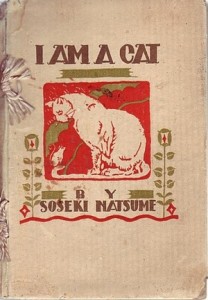I Like __ A Lot
I like “I Am a Cat” a lot
 I Am a Cat was written by japanese author Natsume Soseki in 1906. Its clear, taut prose is notably ‘modern’ for its time. I was affected by its writing more than other books — not just in part due to the unlikely cat narrator — but what it taught me: the best satire is born of compassion. After the following excerpts, I will try to explain what I mean.
I Am a Cat was written by japanese author Natsume Soseki in 1906. Its clear, taut prose is notably ‘modern’ for its time. I was affected by its writing more than other books — not just in part due to the unlikely cat narrator — but what it taught me: the best satire is born of compassion. After the following excerpts, I will try to explain what I mean.
Excerpt:
I hear that, on occasion, this species catches, boils, and eats us. However as at that time I lacked all knowledge of such creatures, I did not feel particularly frightened. I simply felt myself floating in the air as I was lifted up lightly on his palm.
This is early on in the book, where Soseki quickly establishes the satirical tendency throughout the novel. There is a certain rationality that comes easily for the cat, who gains the reader’s authority.
On hearing the front bell (after the break):
Just then the gate-bell sounded: tinkle-tinkle, possibly even ting-ting. Probably a visitor […] Since I never go out of my way to investigate callers, except the fishmonger’s errand-boy, I remained quietly on my master’s knees.
Soseki’s use of ‘the fishmonger’s errand-boy’ is similar to the thousand tiny ‘narrator-meets-reader’ epiphanies I found in Benji Compson’s section of Faulkner’s The Sound and the Fury, wherein the author induces a ‘leap of perception’ in the reader, where the reader is summoned to perceive the world completely differently. Most memorable for me was when 33-yr-old retarded Benji says ‘the barn becomes black’ as a sack is pulled over his head. Soseki here does something similar: pulling the reader into a cat’s head by juxtaposing the irrelevant cat-world (everything except fish) to the relevant cat-world (fish). The novel is loaded with these brilliant subtleties.
And on being painted by his owner:
The next day when , as always, I has having a pleasant nap on the veranda, the master emerged from his study (an act unusual in itself) and began behind my back to busy himself at something. At this point I happened to wake up and, wondering what he was up to, opened my eyes just one slit the tenth of an inch. And there he was, fairly killing himself at being Andrea del Sarto [15th century Italian painter]. I could not help but laugh […] I hadn’t the heart to move: so I bore it all with resignation.
And here is my final point about compassion, or a kind of ‘free empathy’ — which when used as a formal device in literature — can be stunning. Soseki sarcastically describes the master (a stand-in for ‘human’) desperately trying to be an artist. This is, for me, a commentary, or at least jab, on/at the human ego, a psychological trait attributed only to humans. Soseki uses a non-human narrator for ‘objective legitimacy,’ or built-in philosophical verity. The cat sees the futility of the painting, yet ‘bears’ it, because the cat feels compassion (despite all its disclaimers of being too tired) for its master — a compassion Soseki may feel for the human race, the same compassion invoked in the reader.
Orwell and Huxley left me pissed off with nowhere to go. Satire without compassion is pedantic and needlessly grim. I feel better about life because of I am a cat, and I like it a lot.
Tags: Faulkner, Natsume Soseki

Good point. Satire is just mocking if there is no compassion. This post coincides with Justin’s post on Saunders for me. It is the reason I didn’t like The Loved One by Waugh so much but why I do like Cheever, who maybe you could not called satire in a classic sense, but he had this distance mixed with love thing toward his characters.
Good point. Satire is just mocking if there is no compassion. This post coincides with Justin’s post on Saunders for me. It is the reason I didn’t like The Loved One by Waugh so much but why I do like Cheever, who maybe you could not called satire in a classic sense, but he had this distance mixed with love thing toward his characters.